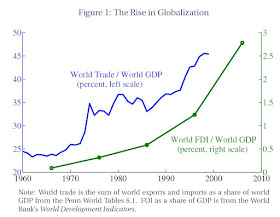Kaldor had identified six stylized facts about economic growth - labor productivity has grown at a sustained rate; capital per worker has also grown at a sustained rate; the real interest rate or return on capital has been stable; the ratio of capital to output has also been stable; capital and labor have captured stable shares of national income; among the fast growing countries of the world, there is an appreciable variation in the rate of growth 'of the order of 2–5%'. All these facts are embodied in the neo-classical growth model and part of any other subsequent explantions of economic growth.
Jones and Romer have their list of new stylized facts about economic growth today.
1. Increases in the extent of the market. Increased flows of goods, ideas, finance, and people — via globalization as well as urbanization — have increased the extent of the market for all workers and consumers.

2. Accelerating growth. For thousands of years, growth in both population and per capita GDP has accelerated, rising from virtually zero to the relatively rapid rates observed in the last century.

3. Variation in modern growth rates. The variation in the rate of growth of per capita GDP increases with the distance from the technology frontier. The variation of growth rates is much smaller for the richest countries than for the poorest. Both rapid catch-up growth and tremendous lost opportunities can be seen in the growth experiences among the poor.

4. Large income and TFP differences. Differences in measured inputs explain less than half of the enormous cross country differences in per capita GDP. A large TFP residual accounts for a large share, at least as large as the measured factor inputs, of the differences in levels of per capita GDP across countries. Poor countries are poor not only because they have less physical and human capital per worker than rich countries, but also because they use their inputs much less efficiently.

5. Increases in human capital per worker. Human capital per worker is rising dramatically throughout the world. The sustained increases in educational attainment may largely explain this.

6. Long-run stability of relative wages. The rising quantity of human capital relative to unskilled labor has not been matched by a sustained decline in its relative price. Despite the large increases in educational attainment by some people in the United States, the wage premiums associated with college and with high school show no tendency to decline. The standard interpretation of this fact is that skill-biased technical change has shifted out the relative demand for highly-educated workers, more than offsetting the downward pressure on the wage premium that is associated with the increase in their relative supply.

They write, "In the near term, we believe that this model should capture the endogenous accumulation of and interaction between three of our four state variables - ideas, population, and human capital. For now, we think that progress is likely to be most rapid if we follow the example of the neoclassical model and treat institutions the way the neoclassical model treated technology, as an important force that enters the formalism but which evolves according to a dynamic that is not explicitly modeled. Out on the horizon, we can expect that current research on the dynamics of institutions and politics will ultimately lead to a simple formal representation of endogenous institutional dynamics as well."
Nice, accurate and to the point. Not everyone can provide information with proper flow. Good post. I am going to save the URL and will definitely visit again. Keep it up.
ReplyDeleteDissertation Help | Custom Dissertation